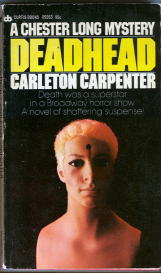CARLETON CARPENTER – Deadhead. Curtis, paperback original; 1974. Paperback reprint: Black Walnut, 1985.

If you were to do a search for Mr. Carpenter on the Internet, you’d find more in the movie and entertainment databases than you will regarding his writing career, which consisted of only a small handful of paperback originals. There’ll be a list of them soon, in case you’re interested.
Before concentrating on the books, though, perhaps it suffices to say that Carleton Carpenter was a both a composer and an actor, in both the movies, on television and in Broadway musicals. One of the top musical hits of 1951 was “Aba Daba Honeymoon,†sung by Debbie Reynolds and Carleton Carpenter (from the film Two Weeks in Love). His career in the movies and on TV is summed up neatly at imdb.com (with some 42 credits as an actor).
Here’s a list of Mr. Carpenter’s mystery fiction. As previously mentioned all of these are paperback originals. * = Chester Long mysteries. ** = billed as a Jasper Wild mystery.
Games Murderers Play. Curtis 07271, 1973; Black Walnut, 1985.
Cat Got Your Tongue? Curtis 07272, 1973; Black Walnut, 1985.
* Only Her Hairdresser Knew… Curtis 07299, 1973; Black Walnut, 1985.
Pinecastle. Curtis 09187, 1973, as by Ivy Manchester; Black Walnut, as Stumped, as by Carleton Carpenter.
* Deadhead. Curtis 09263, 1974; Black Walnut, 1985.
** Sleight of Hand. Popular Library 00661, 1975; Black Walnut, as Sleight of Deadly Hand.
The Peabody Experience. Black Walnut, 1985.
Short story: “Second Banana.†Alfred Hitchcock’s Mystery Magazine, October 1976.
Little is known about Black Walnut Books, but they seem to have been in business only to print Mr. Carpenter’s books.
Whether Jasper Wild appeared in any of the earlier books or was intended to be another continuing character is also unknown. It would also be interesting to learn whether the AHMM short story has either Chester Long or Jasper Wild as characters, leading or incidental. Someone with access to that issue will have to let us know.

As you can see from the cover, Pinecastle (aka Stumped) was marketed and sold by Curtis as a gothic romance, but a quick scan through my copy indicates that the people who are in it all have a very strong theatrical background, which is not surprising.
Chester Long is a hairdresser (straight). Jasper Wild’s occupation is unknown. Someone who has a copy of Sleight of Hand will have to let us know. If by chance he’s a magician as well as a detective, that would be worth knowing.
As for the book at hand, Deadhead, when Chester is offered a position on the side as the head of the hairdresser crew for a musical bound for Broadway, he jumps at it. For the rest of the book he’s a fascinated observer behind the scenes, giving the reader an equally vicarious (and authentic) look at a world largely foreign to us mere mortals. Even so, as Chester admits on page 81:
In my heart I knew I was nothing more than a voyeur who was being overpaid for the opportunity to peep.
The going is as light and breezy as this for over 100 pages, chatty and gossipy in trunk loads. The murder of the show’s bizarrely flamboyant producer does not occur until page 104, which gives Chester the opportunity to show his flair as a sleuth. (Not that there’s any inkling of a previous criminous adventure. Until I checked out the bibliography, I was working under the impression that this was Chester’s first encounter with detective work.)
With the entire company on the road and snowed in as a mammoth snowstorm hits Boston, the effect is that of an isolated country house, which means, of course, besides clues and motives, means and opportunities galore.
And until the end, when things seem to fall apart plotwise, there would be much in the reading to recommend. While Carleton Carpenter is a story teller’s story teller, he unaccountably allows Chester’s previously mentioned flair as a sleuth to fizzle out well before the finale, all of his theories disappearing into smoke. On page 189, after the killer has been nabbed, and the case is being rehashed, Chester says:
This has been hindsight babbling on. I was just as surprised as anyone else.
In any case, all I can offer for a recommendation is hemi-semi-demi-positive one. The book is worth reading for the show business element – that part is simply Grade A all the way – but as a mystery, while it has its moments, the answer, if that’s what you’re asking, is, reluctantly, no. The cast and choreography are excellent, but the book itself? Good, but not up to par. It needs some work.
